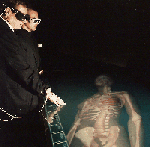
In this new concept, the user no longer experiences simulations of the world on the computer, but the computer is (invisibly) integrated into the user's world. Everyday objects and activities become inputs and outputs for this environment. Computers are considered as a part of daily life and are no longer isolated on desks. The computer system can use and adapt to the rich human living environment. The project aims to transform the usual dialog concept for man-machine communication.
Virtual objects and control tools are located on a real "workbench". The objects, displayed as computer-generated stereoscopic images are projected onto the surface of a table. The computer screen is changed to a horizontal, enlarged worktop version and replaces the two-dimensional flat screen. This view corresponds to the actual work situation in an architect's office, at surgery environments, on the workbench, for three-dimensional atlases, etc. The work action is virtual.
A guide uses the virtual working environment while several observers can watch events through shutter glasses. The guide operates within a non-immersive virtual reality environment. Depending on the application, various input and output modules can be integrated, such as gesture and speech recognition systems which characterize the general trend away from the classical human-machine interface. Several guides can work together locally or use global communication networks such as broadband ISDN. Responsive Environment", consisting of tracking systems, cameras, projectors and microphones, replaces the traditional computer workstation. Thus the computer is increasingly adapted to human needs.
 Responsive Workbench
Responsive Workbench

